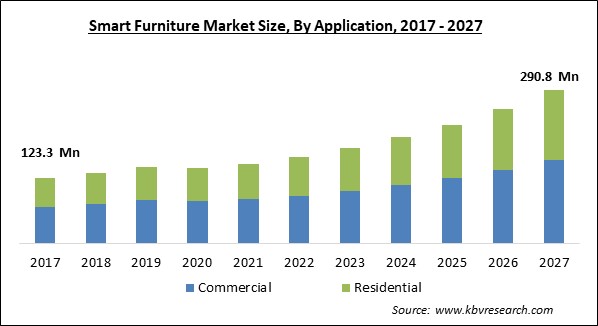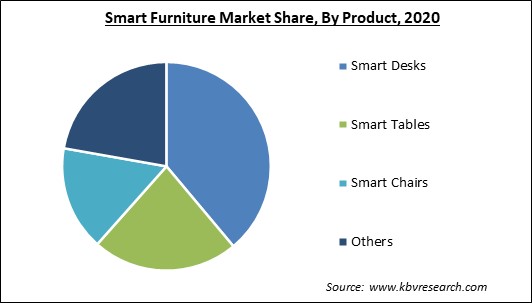The Global Smart Furniture Market size is expected to reach $290.8 million by 2027, rising at a market growth of 11.7% CAGR during the forecast period.
Smart furniture is ordinary furniture, like chairs, desks, tables, and other items in contemporary designs for businesses and homes, that are integrated with an intelligence system or is controlled by a controller. In addition, this furniture is significantly more complex and developed to satisfy the requirements of modern-day lifestyles. A growing number of furniture firms are incorporating smart technologies to enhance their goods and make them more consumer-centric, appealing, and comfy.
All furniture solutions that use information from the surrounding environment to give integrated functionality and comfort to their customers are referred to as smart furniture. It encompasses all objects that facilitate human activities such as seating, eating, sleeping, and so on. A smart piece of furniture usually has a distinct style, which could be conventional, modern, or opulent, and is designed only for the purpose of saving space.
Moreover, smart furniture is designed with a focus on its beauty and impression, and it can also be combined with the newest IT technology, allowing users to connect their smartphone devices to the smart furniture.
The worldwide smart furniture market is predicted to develop as disposable income rises and lifestyles change. In addition, rising investment in home automation solutions, combined with a shift in consumer preference for connected devices, would help the market to flourish. Moreover, some of the major trends of the market are increased use of smart furniture in a variety of industries, as well as shifting customer preferences for a simpler lifestyle. On the other hand, the massive cost of smart furniture goods compared to traditional furniture is expected to act as a significant barrier to the growth of the smart furniture market.
The worldwide smart furniture market is booming due to the rising customer demand for smart home-controlled gadgets. In addition, smart furniture allows users to access a variety of comfort applications, like temperature control in electric mattresses and smart beds, and also allows them to transform basic furniture into numerous space-saving furniture shapes, such as converting a sofa to a bed and vice versa. Moreover, rising consumer demand for furnishings and durable household equipment is expected to contribute significantly to the growth of the overall Smart Furniture market.

Fluctuations in furniture demand, as well as import and export restrictions and supply chain disruptions caused by the COVID-19 outbreak, have impeded the growth of the market during the pandemic period. On the other hand, the market is expected to benefit from the growing trend of smart city initiatives and the increased launch of innovative smart furniture items by industry participants. The abrupt COVID-19 pandemic, which struck the world in the initial phase of 2020, has drastically altered the furniture industry. In addition, the disruptions in the supply chain, as well as the temporary prohibition on global trade, have had a significant impact on countries that rely heavily on imports for their furniture. With the increase in time spent at home due to the pandemic, a significant portion of the world's population was compelled to move to a stay-at-home protocol for a longer period of time, motivating customers to optimize their homes and furniture.
According to the Bank for International Settlements (BIS), the commercial property price index in the United States increased from 400.10 index, 2010 = 100 units in 2010 to 687.20 index, 2010 = 100 units in 2018, while in the Euro area, the index increased from 39.31 index, 2011 = 100 units in 2010 to 467.30 index, 2011 = 100 units in 2018. Furthermore, according to the statistics, the residential property price index in the United States increased from 416.60 index 2005 = 100 units in 2013 to 528.40 index 2005 = 100 units in 2018, while in the Euro Area, it increased from 392.05 index 2015 = 100 units in 2013 to 454.66 index 2015 = 100 units in 2018.
Smart furniture makers are progressively developing innovative furniture that supports a variety of technologies, including wireless smartphone charging, mirror displays of time, date, and news, and sensors embedded in furniture that monitor the user's well-being. As a result, businesses are increasingly adopting smart office furniture to track employee behaviors such as how long they sit, stand, or walk away from their desk, as well as the number of calories they burn. In addition, many end users are increasingly gravitating toward smart furniture due to the furniture's multiple transformation capabilities, such as stools that transform into modular sofas at the touch of a button on the user's smartphone, and smart beds that monitor the user's heart rate, respiration rate, sleeping posture, and other parameters.
Companies are integrating modern features in smart furniture including Wi-Fi, sensors, and others, which can make the lives of users significantly better. On the other hand, the cost of integrating these features is quite massive, discouraging many companies and homeowners to embrace smart furniture. In addition, many companies struggle to incorporate smart furniture into their premises because they face budget constraints. Moreover, numerous organizations are still using traditional furniture and are hesitant to replace them with modern furniture in the near future. This is because smart furniture has built-in technologies and if a part stop working properly, the cost of replacement is high. Many players are currently working on various systems that use a variety of technologies.

Based on Application, the market is segmented into Commercial and Residential. The Residential segment held a significant revenue share of the Smart Furniture Market in 2020. This is because of the rising demand for furniture in living rooms and bedrooms, as well as an increase in government-sponsored real estate development projects, particularly in metropolitan regions. Additionally, the changing tendency of consumers toward the use of IoT-connected furniture is expected to drive the growth of this segment during the forecasting period. Household disposable income in the United States increased from 40624.23 USD/capita in 2010 to 50294.00 USD/capita in 2017, according to the Organisation for Economic Co-operation and Development (OECD). Furthermore, the growth of the smart furniture market is fueled by an increase in demand for space-saving furniture and the expansion of online shopping.
Based on Product, the market is segmented into Smart Desks, Smart Tables, Smart Chairs and Others. In 2020, the Smart Desks segment acquired the largest revenue share of the Smart Furniture Market. As corporations furnish new office spaces, a strong increase in commercial and office building construction and remodeling activities is expected to boost demand. In addition, replacement activity has previously played a modest part in supporting demand, owing to product durability and a lack of innovation, but trends toward more open, collaborative workspace design will promote a rise in replacements.
| Report Attribute | Details |
|---|---|
| Market size value in 2020 | USD 142.9 Million |
| Market size forecast in 2027 | USD 290.8 Million |
| Base Year | 2020 |
| Historical Period | 2017 to 2019 |
| Forecast Period | 2021 to 2027 |
| Revenue Growth Rate | CAGR of 11.7% from 2021 to 2027 |
| Number of Pages | 138 |
| Number of Tables | 259 |
| Report coverage | Market Trends, Revenue Estimation and Forecast, Segmentation Analysis, Regional and Country Breakdown, Companies Strategic Developments, Company Profiling |
| Segments covered | Product, Application, Region |
| Country scope | US, Canada, Mexico, Germany, UK, France, Russia, Spain, Italy, China, Japan, India, South Korea, Singapore, Malaysia, Brazil, Argentina, UAE, Saudi Arabia, South Africa, Nigeria |
| Growth Drivers |
|
| Restraints |
|
Based on Regions, the market is segmented into North America, Europe, Asia Pacific, and Latin America, Middle East & Africa. In 2020, North America emerged as the leading region in the overall Smart Furniture Market by collecting the largest revenue share. The promising revenue share of the regional market can be credited to a rise in the number of working professionals and the rapid adoption of technology. However, large improvements in other years were offset by a sharp decrease in demand coinciding with the 2007-2009 US recession, resulting in no overall change in demand for the 2006-2016 decade. Demand for office furniture is very cyclical, varying in reaction to macroeconomic factors such as new office building development, capital investment, and employment levels.
Free Valuable Insights: Global Smart Furniture Market size to reach USD 290.8 Million by 2027
The market research report covers the analysis of key stake holders of the market. Key companies profiled in the report include Sleep Number Corporation, Inter IKEA Systems B.V., Eight Sleep, Hi-Interiors Srl, Fonesalesman Ltd., Nitz engineering Srl, Desktronic, Modoola Limited, and Sobro (StoreBound LLC).
By Application
By Product
By Geography
The global smart furniture market size is expected to reach $290.8 million by 2027.
A rise in trend for furniture that saves space are driving the market in coming years, however, the massive cost of Smart Furniture and Compatibility issues limited the growth of the market.
Sleep Number Corporation, Inter IKEA Systems B.V., Eight Sleep, Hi-Interiors Srl, Fonesalesman Ltd., Nitz engineering Srl, Desktronic, Modoola Limited, and Sobro (StoreBound LLC).
Yes, With the increase in time spent at home due to the pandemic, a significant portion of the world's population was compelled to move to a stay-at-home protocol for a longer period of time, motivating customers to optimize their homes and furniture.
The Commercial segment acquired maximum revenue share the Global Smart Furniture Market by Application in 2020; thereby, achieving a market value of $158.6 million by 2027.
The North America market dominated the Global Smart Furniture Market by Region in 2020, and would continue to be a dominant market till 2027; thereby, achieving a market value of $101.8 million by 2027.
Our team of dedicated experts can provide you with attractive expansion opportunities for your business.

